The Definitive Guide to Sanitary and Hygienic Design for Food Equipment Manufacturers
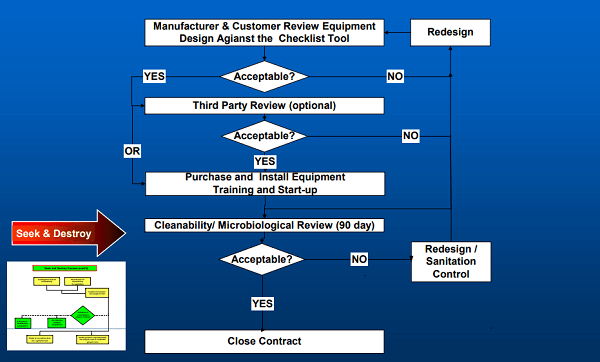

Stories about people getting ill from contaminated food often dominate the headlines. Sometimes it’s the result of poor food preparation. Other times, illnesses can be traced to inadequate sanitary practices – which sometimes arise from poorly designed food equipment. ![]()
Contamination poses a constant risk to food manufacturers and retailers. It only takes one mistake to allow bacteria to spread and infect a batch of products sent out for consumption by the public. The costs associated with trying to repair the situation don’t compare to the damage done to a business’ reputation.
Those fears make it doubly important for food equipment manufacturers to provide products designed with cleanliness as a top priority. Properly constructed machinery and cooking tools make it easier for food manufacturers to keep their equipment in a state with a low risk of contamination.
In this guide, we’ll discuss:
The intent of this guide is to provide a thorough understanding of the proper application of sanitary and hygienic practices to food equipment design. Manufacturers and other industry insiders should gain a clearer understanding of making all aspects of food production and distribution as safe as possible.
It’s up to each manufacturer or retailer to follow industry standards designed to protect the public. Any process breakdowns resulting in potential contamination should be addressed immediately.
Sanitary and hygienic design take into account all the machinery and related infrastructure involved in processing food for public consumption. Different places use different methods depending on the type of product produced or served. But there are common standards and best practices that all manufacturers should be following to prevent accidental contamination of food sources. 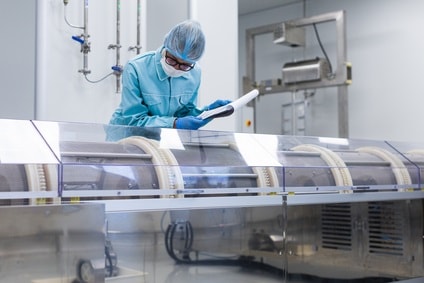
The core principles of sanitary food equipment design include (but are not limited to):
Food equipment manufacturers should always look for ways to help customers keep their places of business bacteria-free. Using machinery designed with hygienic design principles in mind helps food manufacturers limit the risk of toxins or other microbiological organisms coming into contact with food supplies. The good news is that sanitary and hygienic design doesn’t necessarily cost more than the same equipment would cost without these principles in mind. That said, there is sometimes a higher upfront cost due to certain material choices, but the benefits of these choices reduce operating costs in the long-term.

Screenshot via Canadian Meat Council (CMC) by AMI (American Meat Institute) Equipment Design Taskforce
The concept of sanitary and hygienic design has grown as concerns about food safety rises among the public. The rise of social media and rapid response means that reputation damage comes swiftly once the word spreads of a potential outbreak.
That has food processing plants and food retailers on the hunt for products designed to decrease the chances of any type of contamination. Food equipment manufacturers should heed these concerns and adjust their own constructs to the demands of the evolving needs of their customers.
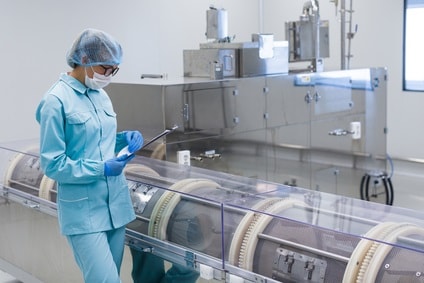
The US Department of Agriculture maintains oversight of food safety in the United States. Sub-branches oversee the various aspect of food production across different industries.
Food Safety and Inspection Services (FSIS) – Assumes primary responsibility for approving any equipment used in plants processing eggs, meat, and poultry.
Agricultural Marketing Service (AMS) – Controls the approval process for equipment used by the dairy facilities they’re responsible for inspecting.
Food and Drug Administration (FDA) – Uses Current Good Manufacturing Processes (CGMPs) outlining the construction and cleanability of any food equipment used in food processing plants. They also developed a program evaluating equipment used in any Grade A Dairy Facilities.
A number of other organizations maintain standards for sanitary food equipment development.
3-A Sanitary Standards, Inc. – Funded by organizations from the dairy industry, various regulators, and equipment manufacturers.
The National Sanitation Foundation (NSF) – Outlines standards adopted by those in the retail and foodservice industry. In recent years they’ve begun offering their own input into proper standards for manufacturing food processing equipment.
The European Hygienic Design Group (EHEDG) – Oversees the approval of food processing equipment in Europe. They’ve published guidelines for designing and constructing any machinery used in food processing plants. American companies looking to sell their food processing equipment there need to ensure their products pass the testing guidelines established by this body.
The governing bodies and regulatory agencies overseeing sanitary and hygienic design for food equipment have certain differences due to their sphere of influence. All agree in general on the need for prioritizing food safety above all else.
Many, like the 3-A Sanitary Standards, provide certifications designating that equipment meets the proper standards for a particular industry. All have their own systems of reporting violations and targeting any food equipment manufacturers seeking to find shortcuts that put the safety of the public at risk.
Any manufacturer caught falsifying approvals from the FDA or other oversight organizations run the risk of being shut down and permanently barred from the industry.
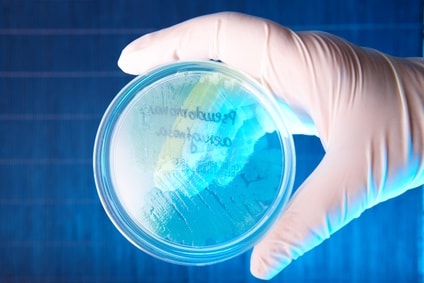
The central concern of any design principles should be the surfaces food could potentially come in contact with. They’re grouped into two categories:
Any surfaces intended to come into direct contact with any food should meet these requirements:
Surfaces covered in any type of metal alloy or non-metal material must still meet the above standards. You should never see flaking, bubbling, chipping or any type of distortion regardless of factory environment conditions. Any modifications used during fabrication – like welding or soldering – should use appropriate materials and produce a surface meeting sanitary and hygienic design principles.
Different materials meet different requirements depending on the type of food processing machinery needed by a factory, facility, or retail environment. Some manufacturers incorporate antimicrobial coatings into their designs to improve safety. Any materials or surface coatings used should conform to the standard needed by that particular industry.
Metals:
Stainless Steel – The preferred metal of choice due to its resistance to corrosion and the durability it brings to various machine designs. Designers should account for the composition of nickel and metal in the material they choose. Certain combinations should only be used for more industrial purposes like pipe construction, not building food equipment.
Titanium – The cost prohibits the more wide-spread use of this metal. It’s also corrosion-resistant and long-lasting. You’ll often find it in stainless steel alloys used to build machines handling foods with a high level of acidity.
Platinum – Similar to titanium in providing higher quality but prohibited from more extensive industry-wide usage due to its cost.
Copper – Used primarily for equipment in the brewing and cheese industries. Should not be used with high-acid food as the acid residues tend to leach into the metal.
Aluminum – Often used for food processing machinery designed with a lighter weight in mind. It’s extremely susceptible to corrosion and becomes warped and cracked after a long period of use. Oxidizing cleaning products accelerate the decline of the metal. Most aluminum products designed for food contact must be coated with some sort of plastic coating to protect against this.
Carbonized metal and cast iron – Only used for cooking surfaces and frying equipment.
Non-Metals: 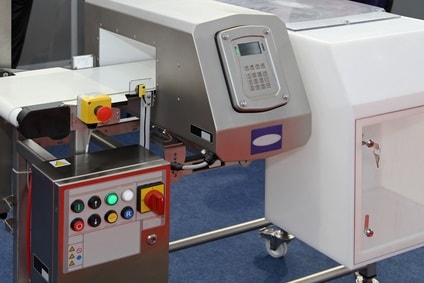
Rubber and Plastic – Any materials used must meet specific standards outlined by 3-A Sanitary Standards, Inc. The FDA considers any products designed for multiple uses as an indirect food additive in some instances.
Ceramics – You’ll mostly see this material used in membrane filtration systems. Certain other products requiring wear resistance might also incorporate its use to some capacity.
Glass – Limited in use for food contact surfaces due to fears of breakage. Any glass products used must past tests ensuring its durability, resistance to shattering, and heat resistance. You’ll also see glass used as a way to provide a line of sight inside machinery or glass piping applications.
Paper – Typically used for gaskets in piping constructs designed to be taken apart on a daily basis. They’re often intended to be used only once.
Wood – Its porous nature makes it a very poor choice as a food contact surface. Most regulators restrict the use of wood in food service outside of cutting boards or butcher blocks.
Non-metals must meet the same cleanability and sanitary design standards required of metal. The lack of corrosive resistance and lower durability means that strict inspection and testing standards need to be in place to watch for the deterioration of products built with non-metal materials.
Any alterations to surface materials like polishing, texturing, or grinding should be done only to produce a final finished surface that is:
Recent methods adopted by the 3-A Sanitary Group outline industry standards on calculating an acceptable food contact surface. This involves determining the surface roughness average (Ra value) measured by an instrument called a profilometer. It measures the peaks and valleys of a seemingly smooth surface using a diamond-tipped stylus.
Food equipment should be designed and constructed free of any sharp corners or crevices where bacteria could breed. The construction process should allow for easy assembly and disassembly for cleaning and inspection needs. Constructs like vessels, tanks, or chambers should be self-draining and provided access to a draining port with nothing getting in the way.
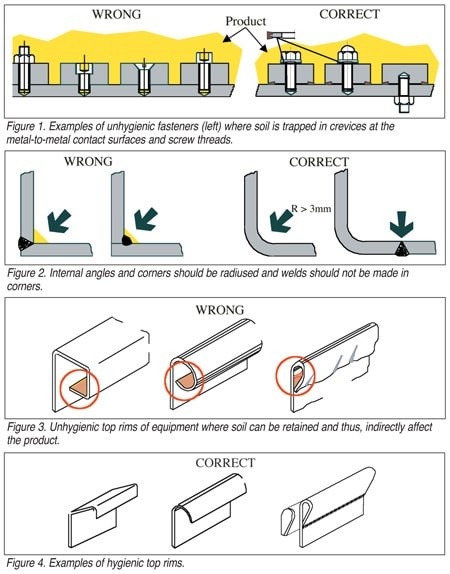
Screenshot via Food Safety Magazine
Any piping systems not meant to be taken apart should be angled downward for easy drainage. Modern food processing systems with piping systems built with a cleaning-in-place (CIP) design must be closely monitored to make sure it’s draining properly.
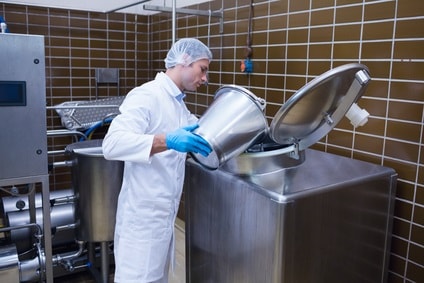
It’s possible for food to accidentally come into contact with surfaces like floors, doorknobs, or other parts of the food processing plant not intended for that purpose. Places like this provide a fertile breeding ground for bacteria like listeria to thrive if proper sanitation measures aren’t taken.
The surfaces should also be inspected for how well they conform to sanitary and hygienic design principles. They should still be made of a material that’s easily cleaned and suited to the types of products being manufactured.
Design tubular frameworks to be sealed. Avoid penetrating them with rivets, bolts, or studs. Crevices left behind by these binding materials allow micro bacteria to build and spread to different areas of a food processing plant.
Avoid having areas where dust can build up. Try to fabricate any equipment tops, shields, or covers at a 45-degree angle. Seal the base and avoid any type of hollow design. Following general food plant facilities best practices and controls will go a long way in ensuring the safety of food products produced, as well as plant workers.
Make sure equipment gets installed in a logical order designed to provide maximum protection against any type of cross-contamination. Leave ample space around equipment and between any piece of equipment and a wall to allow for a thorough cleaning.
Check for any places that might encourage rodents or insects to gather. It’s best to leave about four inches between a piece of equipment and the wall. Seal floor-mounted equipment to the floor, platform, or related pedestal. It should be at least six inches from the floor otherwise.
Seal table-mounted equipment to the tabletop or make sure it’s no less than four inches from the countertops.
Any perceived complexity in the concept of hygienic and sanitary design should be compared to the benefit obtained from using equipment designed for easy cleanliness and maintenance. It makes things easier for your labor force and provides long-term savings thanks to the payoff obtained from using well-designed equipment built for durability.
Sanitary and hygienic design helps equipment manufacturers and, subsequently, food processing plants, remain compliant with the latest regulations and recommended best practices. In addition to ensuring the safety of the food supply, sanitary and hygienic design principles simply make practical (and economic) sense.
For more information on sanitary and hygienic design for food equipment manufacturing, visit the following resources:
Our sales engineers are experts in automatic asset tracking, tagging and identification,a nd can answer all your questions. Get in touch now.
Lets Talk ›